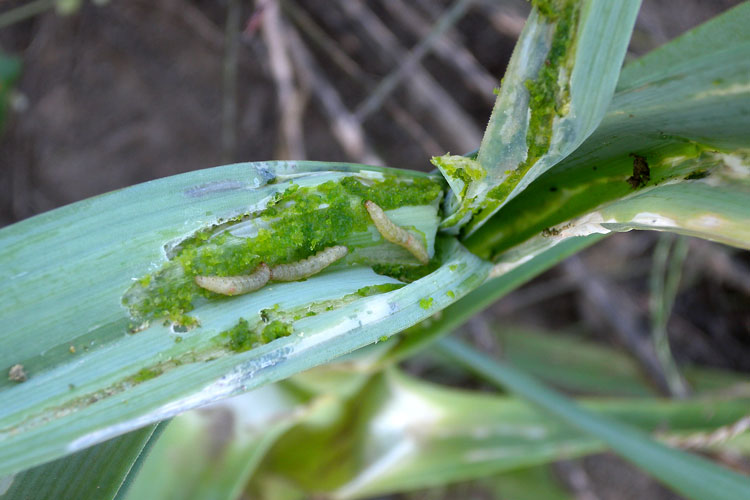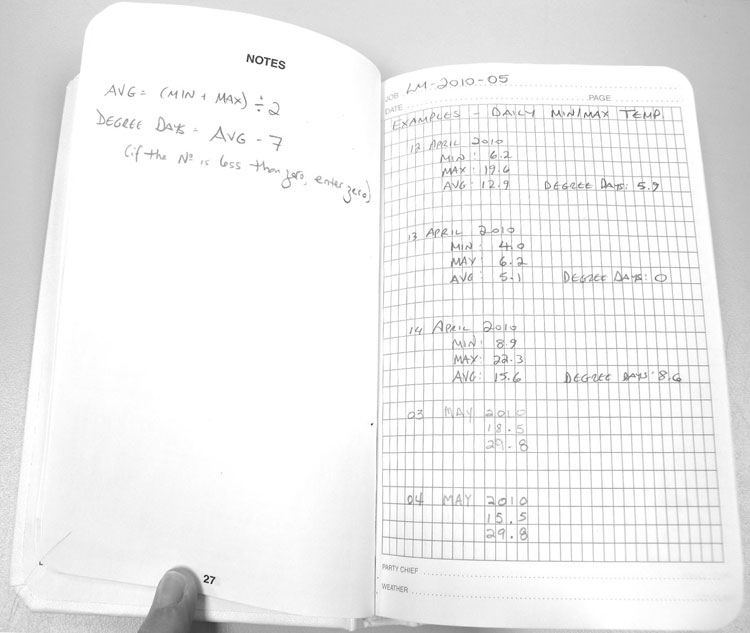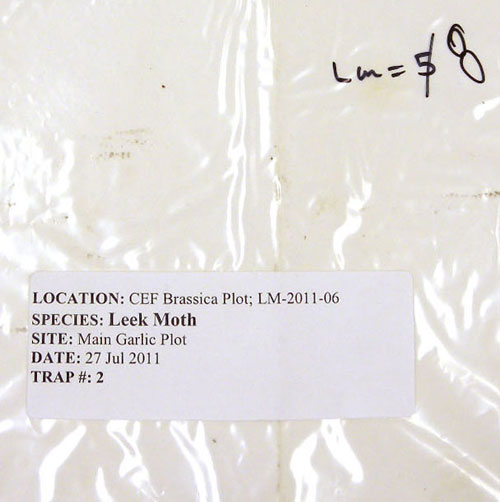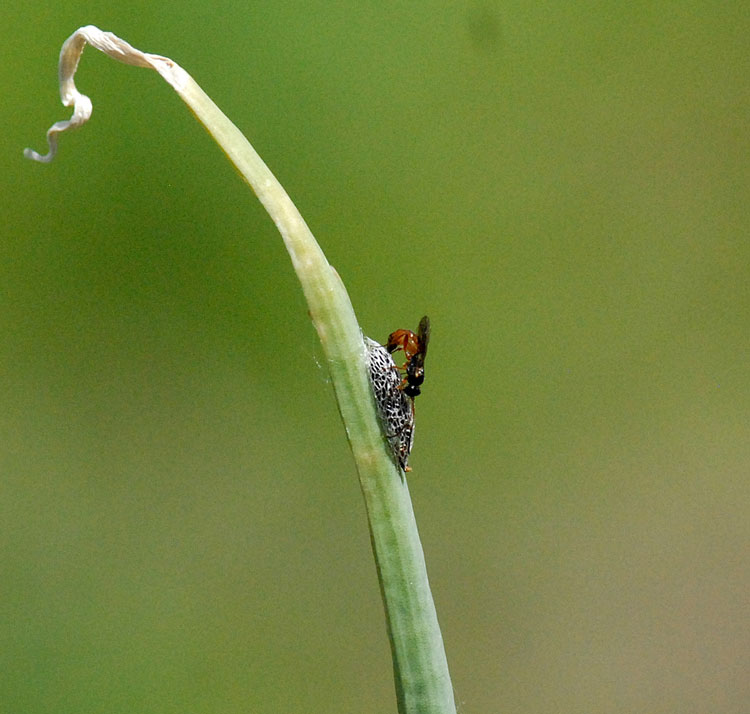Sustainable Crop Protection
Results from the Pesticide Risk Reduction Program

Background
The leek moth, Acrolepiopsis assectella, (Figure 1) is an invasive alien species from Europe that causes damage to onions, leeks and garlic. Larvae cause damage when they penetrate the young leaves and flowers of the crop in order to feed (Figure 2). This feeding weakens and withers the plant reducing the value of the crop, and in some cases renders it unmarketable. First detected in Eastern Ontario in 1993 and Quebec in 2001, leek moth has rapidly expanded its range and, as of 2013, was detected as far as Southwestern Ontario, Prince Edward Island and New York State.
The Pesticide Risk Reduction Program of Agriculture and Agri-Food Canada's (AAFC) Pest Management Centre has, over the past ten years, supported several projects towards the development of an Integrated Pest Management (IPM) strategy to address this emerging pest issue. Project work included field and laboratory investigations of leek moth's biology; biological control studies using the introduced parasitoid Diadromus pulchellus; and the evaluation of other reduced risk tools such as biopesticides and row covers. A farmer participatory research approach was undertaken, actively engaging local growers, allowed research and development activities to occur in parallel with technology transfer. This factsheet summarizes the tools developed, as a result of the work supported under the Program.
Establishing Base Knowledge – Leek moth life history in Canada

As a new pest to Canada, initial work focused on determining the life cycle of the pest under Eastern Ontario conditions. Pheromone traps were used to monitor flight patterns and numbers of adult leek moth during the growing season, while field populations of leek moth larvae and pupae were estimated through destructive plant sampling. Assessment of garlic scapes and bulbs were used to estimate damage to marketable products.
It was found that the development of leek moth populations in Canada requires 441.7 day-degrees from egg to adult. In the Ottawa area, pheromone trap data indicated that there are three flight periods: a spring flight of adults that overwintered, an early summer flight of 1st generation adults and a late summer flight of the 2nd generation. Further developmental studies confirmed that 3 generations of leek moth occur in a year in Canada. Depending on ambient temperatures, the life cycle can take from 3 to 6 weeks to complete.
Developing the Integrated Pest Management Toolbox
Various tools to control leek moth were developed and tested over the course of 10 years of work. Together these tools form a multipronged, reduced risk, integrated pest management approach.
Decision Support Tools: Monitoring System
To help growers make pest management decisions, a system for monitoring leek moth was created using pheromone traps combined with temperature data and knowledge of leek moth development (Figure 3). This system helps growers and crop specialists to predict when leek moth will be present in different developmental stages in the field, allowing targeted and effective pest management treatments if needed.

Figure 3a) pheromone trap showing placement of lure and sticky bottom

Figure 3b) notebook to record data

Figure 3c) sticky bottom with moths

Figure 3d) label to identify location and date sticky bottom removed

Figure 3e) manual minimum-maximum thermometer

Figure 3f) electronic minimum-maximum thermometer

Figure 3g) pheromone lure
Physical Barriers: Row Covers

Row covers, which physically block leek moth adult females from laying eggs on plants (Figure 4), were found to be as effective as pesticides in reducing damage from leek moth. On-farm experiments indicated that fewer plants under row cover had damage than without row cover, in some years there was no damage observed on the protected plants.
Control Products: Biopesticides
Laboratory experiments and subsequent field trials were carried out to determine which reduced risk products could provide effective control of leek moth. Dose-response studies indicated that spinosad and Bacillus thuringiensis var kurstaki (Btk) products were effective in causing mortality of leek moth. In the field, use of spinosad-based products resulted in fewer leek moth larvae and less damage than Btk products. Both products have now been registered for use. The Pest Management Centre's Minor Use Program contributed to the registration of several spinosad products.
Biological control agent: Diadromus pulchellus



Background parasitism of leek moth in the Ottawa area was low, emphasizing the need to release a more effective, pest specific, natural enemy. Initial studies conducted in Switzerland by CABI Switzerland during 2004-2006 found Diadromus pulchellus, a parasitic wasp, that was well-synchronized with leek moth and caused the highest mortality to leek moth among the natural enemies studied (Figure 5). Literature records indicated that this parasitoid was specific to leek moth, making this agent ideal for further investigation. Extensive host range studies for D. pulchellus were carried out in 2006-2007 in Europe and in containment in Canada to confirm this parasitoid could be safely introduced in Canada. A petition for release of the agent was submitted to the Canadian Food Inspection Agency (CFIA) and regulatory approval was granted by CFIA in the fall of 2009 and releases of D. pulchellus began in 2010.
The parasitoid D. pulchellus was reared in the lab for release at four locations around the Ottawa Valley (Figure 6). More than 10,000 D. pulchellus adults were released from 2010-2012, from the time of the first generation of leek moth until the end of the season (Figure 7). Recoveries documented survival of D. pulchellus in the field for at least one complete generation during each field season. Progeny of individuals released the previous year were also recovered the following spring, indicating that D. pulchellus can successfully overwinter in eastern Ontario and that a local population has been established. Immediate parasitism levels of almost 50% can be achieved when sufficient numbers of the biological control agent are present. The release and establishment of the biological control agent will, over time, provide a long term approach to keeping leek moth levels under control.
Bringing it all together: An Integrated Pest Management approach
By using the monitoring tools developed - pheromone trap data, ambient air temperature and the life cycle model - growers can determine when leek moth adults are flying and laying eggs, as well as estimate when eggs will hatch and when the first generation will mine into the plant. Growers can then take action when tools will be most effective. Row covers should be placed over plants before leek moth adults' start flying to physically block adults from laying eggs on the plants. A flight graph built on temperature data will determine when application windows for biopesticides are most effective, as they must be applied before the larvae mine into the plant. Life cycle information also helps determine when pupae will be in the field and as a result when D. pulchellus will be active, indicating to growers when not to apply chemical insecticides products that may inadvertently damage the parasitoid.
Knowledge and Technology Transfer – Working with Growers
Engaging growers from the early stages of the study and working with them every step of the way was an important success factor to the outcomes of this work. Local growers were recruited as co-operators to contribute to the project through a farmer participatory approach. After an initial visit to explain the project and adapt the experimental set-up to individual needs, co-operators were engaged through regular on-site visits and discussions during each field season. Full reports were shared and annual meetings were also held with each participant to discuss the results from the previous year and to plan for the next field season. An end-of-project questionnaire completed by grower co-operators indicated that participants were enthusiastic about being part of the study and benefitted from the regular interactions with the researchers and provincial crops specialists.
Knowledge was also transferred to growers through workshops hosted in collaboration with provincial partners, factsheets and handouts (Figure 8), as well as by the farmer participatory approach itself.

As a result of this work, onion, leek and garlic growers have alternative practices and reduced-risk products available to manage leek moth in their allium crops. Implementing these reduced risk practices will allow the continued production of a high quality harvest in an environmentally sustainable way.
Acknowledgements: Multi-stakeholder collaboration and partnerships among pest management experts were essential in accomplishing these results. The work presented here was led by AAFC research scientist Dr. Peter Mason with Andrea Brauner and Jacob Miall, in collaboration with: crop specialists Margaret Appleby, Dr. Jennifer Allen, and Marion Paibomesai (Ontario Ministry of Agriculture, Food and Rural Affairs); Dr. Naomi Cappuccino (Carleton University); and Dr. Wade Jenner and Dr. Ulrich Kuhlmann (CABI Switzerland).
Contact Information
For more information about this project, please contact: Peter Mason, Ph.D.
About the Pesticide Risk Reduction at Agriculture and Agri-Food Canada
The Pesticide Risk Reduction team delivers viable solutions for Canadian growers to reduce pesticide risks in the agricultural and agri-food industry. The team achieves this goal by funding integrated pest management projects and coordinating pesticide risk reduction strategies developed through consultation with stakeholders and pest management experts. Other sustainable crop protection factsheets are available. For more information please visit the Pest Management Centre.